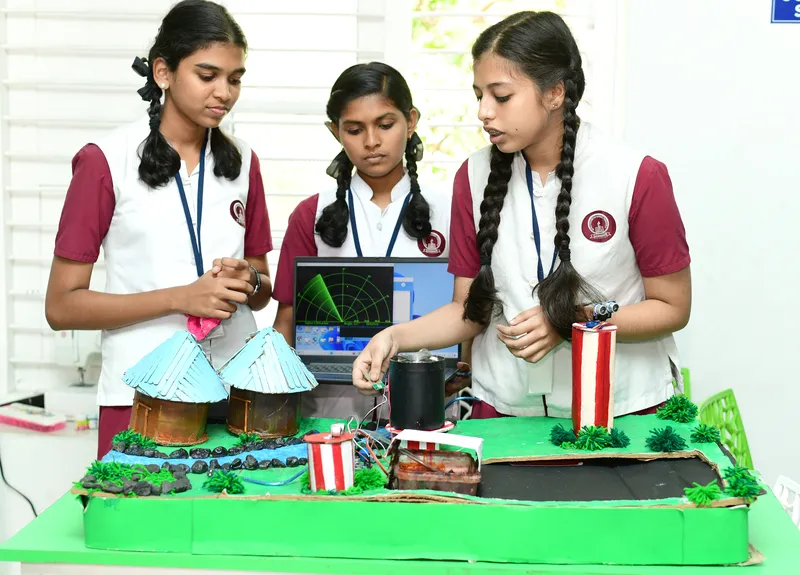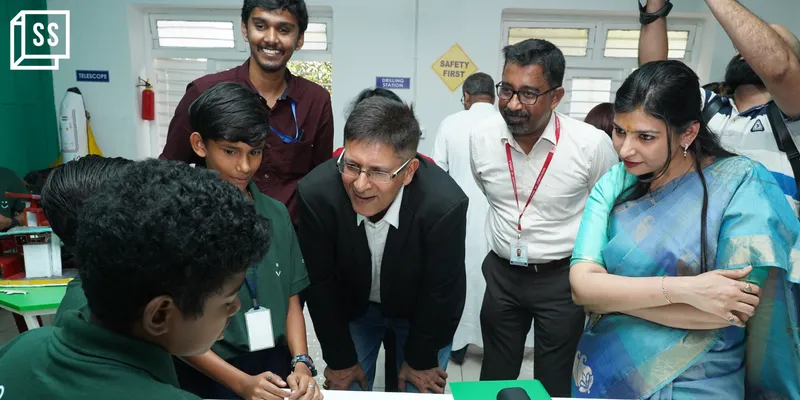How these students from Thrissur are tinkering their way to a bright future in STEM
The Grand Student Innovation Showcase, organised by OPPO India in collaboration with NITI Aayog’s Atal Innovation Mission, commemorated the first anniversary of Atal Tinkering Lab (ATL) at St Paul’s CEHSS in Kuriachira, Thrissur. SocialStory attended the event and spoke to the “tinkerers”.
Ashwathy NG, Annliya Deepak, and Maria CJ of St Paul’s CEHSS, a school in Kuriachira in Kerala’s Thrissur District, have spent the past year developing a model of a Smart Farming System.
The project combines an Arduino UNO-based automatic irrigation system with components like ultrasonic sensors, servo motors, buzzers, processing software, a soil moisture sensor, a relay module, and a water pump model.

The winning team with their model
The model blends innovation with social impact—addressing the man-animal conflict and also water scarcity in an era of climate change.
This is the result of hours of hard work in the on their school premises, which sometimes extended beyond class hours and into weekends.
The group of three girls won the first prize in the Grand Innovation Showcase organised to celebrate the first anniversary of the partnership between OPPO India and NITI Aayog in a Public Private Partnership (PPP) ATL model that aims to make it more inclusive, with far-reaching results.
Established by the Atal Innovation Mission in schools across India, ATL aims to inculcate a design mindset, computational thinking, adaptive learning, and physical computing among students from standard six to ten.
The ATL at St Paul’s CEHSS in Kuriachira, Thrissur, was inaugurated last year by Rajeev Chandrasekhar, Minister of State for Skill Development and Entrepreneurship and Electronics and Information Technology. It has been established as a collaboration between Atal Innovation Mission (AIM) and OPPO India, with Learning Links Foundation, an NGO, as the implementation partner. Chandrasekhar is also an alumnus of the school.
A path of continuous learning

Vivek Vashishta and Deepali Upadhyay interact with students
The girls at St Paul’s CEHSS said that the ATL orientation a year ago set them off on a path of discovery and learning. Aided by their mentors from the Learning Links Foundation, they began researching the effects of water scarcity and climate change on agriculture.
“This is a four-in-one project that combines different elements to protect the farmer from the vagaries of nature. This comprises a radar system, an automatic irrigation system, a shutter system, and a frequency system,” explains Maria.
“The radar system works on ultrasonic sensors, which detects animals close by and warns the farmer. The shutter system detects rainfall patterns through rain sensors by which the amount of water needed for each crop can be calculated and a shutter falls over crops that need less water. The automatic irrigation system measures soil moisture diligently,” adds her teammate Annliya.
The girls admit that their first model was not as ambitious as their prize-winning one. After suggestions from the OPPO team, they scaled their model to include more features.
The ATL at St Paul’s CEHSS works on a hub-and-spoke model with the school being the hub and three other community schools in the district—St Mary’s CGHSS, St Mary’s CUPS, Chiyyaram; and St Raphael’s CGHSS, Ollur, also participating in the activities.
They may not have everyday or continuous access to the ATL like the students at St Paul’s, but that did not deter a group of ninth-standard students from St Mary’s CGHSS to come up with the idea of Smart Goggles, which won the third prize in the innovation showcase.
Moved by the plight of one of their juniors who was visually impaired, Hannah Reethu Sojan, Anncila Reji, Annlin Bijoy, and Anjeleena VJ have built a prototype of Smart Goggles that is equipped with an ultrasonic sensor that detects obstacles in its path and triggers a buzzer if the distance is unsafe.
Speaking on behalf of her team, Hannah says, “This technology will help the visually impaired to navigate independently. Right now, our model just detects objects within a short distance, but we aim to make it up to a distance of one kilometre.”
Innovation with a social impact was also evident in the second-prize winning model of The Caring Robot developed by Christy F Vattakuzhy, Daniel Christo KJ, and Sreenandan CS from St Paul’s CEHSS.
The robot delivers items through controlled gear motors and servomotors and includes elements like songs and light effects, controlled by a remote controller app. It also has interactive features such as handshakes and games that are run by IR sensors in its hands.
A model that works
There are 10,000 Atal Tinkering Labs in schools across the country, but Deepali Upadhyay, Programme Director, Atal Innovation Mission, NITI Aayog, believes that they have barely scratched the surface. This is why a PPP (public-private partnership) model along with collaborations with state departments will make ATLs accessible to every student in the country.
Upadhyay also elaborated on how the impact of ATLs is measured.
“The high-level objective of this programme is to inculcate a design thinking and problem-solving mindset, with entrepreneurship and innovation being the eventual goals. We have an online monitoring mechanism called the ‘My ATL’ dashboard where all our PPP partners also get on board. Schools on a monthly basis report activities and how many innovation projects were created or how many patents were filed,” she says.
These will also include information on participation in workshops, training, capacity building or competitions. Impact studies are also published as part of the programme.
Vivek Vasishtha, Vice-President, Public Affairs, OPPO India, who personally spoke to the groups that presented the 20 projects, was impressed by their depth of knowledge, research, and presentation skills.
“We are keen to explore more possibilities because I believe this is a true meeting of minds that led to this Public Private Partnership. We believe in NITI Aayog’s vision of inculcating STEM education during the early stages of schooling. We are also proud to see the projects that have come out of this lab,” he says.
Shaiju and Jackson from the Learning Links Foundation are the mentors of the programme, and apart from teaching students at the ATL at St Paul’s, they also visit the cluster schools regularly. They are instrumental for over 70 students “tinkering” at the ATL and developing a lifelong love for science.
Upadhyay admits that one of the biggest challenges of the ATLs is that it is not integrated into the school curriculum.
“Now, after 10,000 ATLs in the country, we feel we are ready for it to be included in the curriculum and give it due attention and focus. Right now, it varies across states and schools. Another shortcoming is the lack of human resources; at present, it’s an additional responsibility for the teachers. We need dedicated teachers to teach “tinkering and innovation,” she says.
Also, participation from community schools can be lower than that from the hub school due to various factors such as distance, transport, parental permissions, etc.
It’s way past their lunch-time but the excitement of the “tinkerers” is palpable, as they are eager to explain what they have created. They are also dreaming big—they want to become scientists and engineers, and one girl wants to conquer space.
It’s evident that seeds of STEM education have been sown, along with a social conscience. They are growing wings; we just have to wait for them to fly!
(The copy has been updated to correct a typo)
Edited by Megha Reddy







